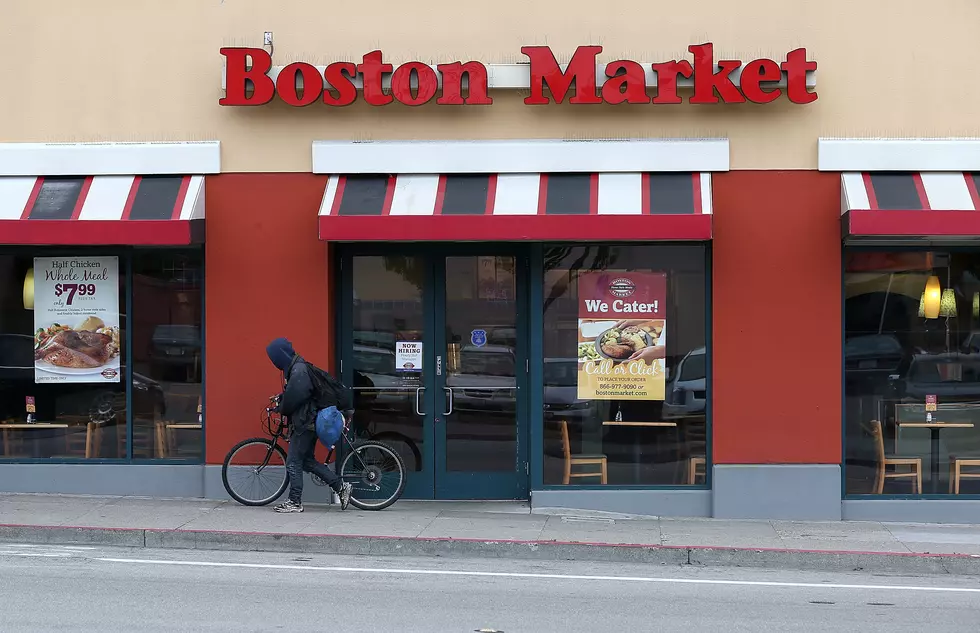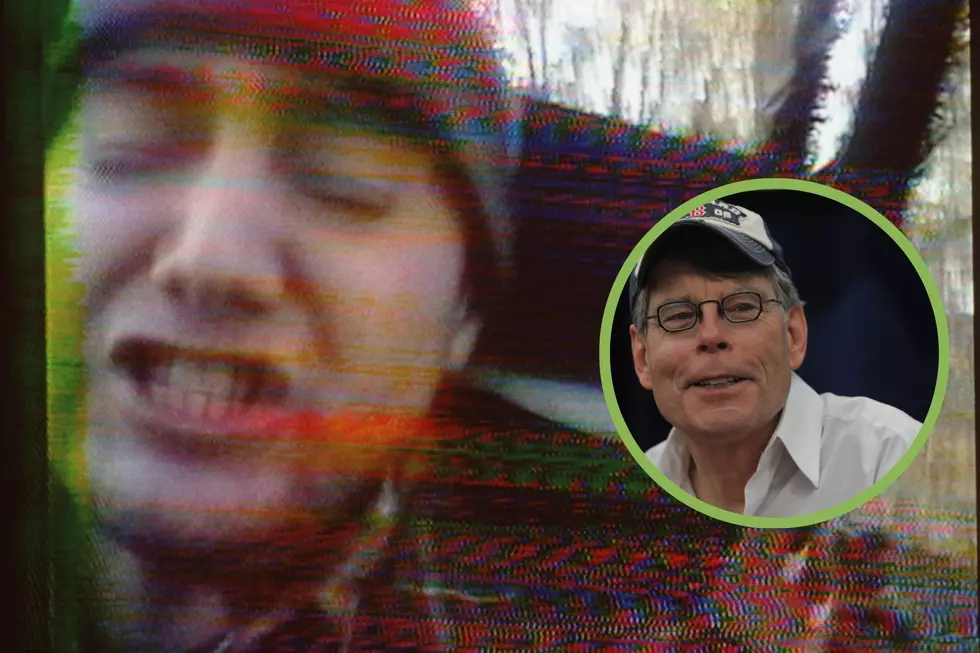
The Wizard Of Oz/Dark Side Of The Moon Mystery: Are There Higher Powers At Play?
There are many who want to believe that the members of Pink Floyd had everything to do with the synchronization of their classic 1973 album "The Dark Side of the Moon" with the 1939 film "The Wizard Of Oz". I, however, would like to believe it was something far bigger than that.
Back in the mid '90s the Fort Wayne (Indiana) Journal Gazette published an article citing the internet discussion group alt.music.pink-floyd with discovering the many eery similarities that occurred when the opening heartbeat of "The Dark Side Of The Moon" was cued up exactly on the third roar of the MGM lion. A few years later the story began to reach an even wider audience when Boston radio DJ George Taylor Morris discussed Dark Side of the Rainbow on the air, which led to more articles and even a segment on MTV News. It was now a worldwide sensation.
Eventually it got to the point where the urban legend became such a phenomenon that the media felt it necessary to ask the members of the band about it. While David Gilmour, Richard Wright, Nick Mason and even engineer Alan Parsons have all denied it and even dismissed it as being simply nonsense, Roger Waters has yet to comment on it one way or the other.
I still can't help thinking, however, that there are higher powers at play which lead Pink Floyd fans all the way back to the very beginning of the Yellow Brick Road. As we get closer to the entrance we begin to make out the shadowy figure of a man who is at the very heart and soul to this story. Upon an even closer look we finally see the enigmatic and mysterious man known as The Crazy Diamond: Syd Barrett.
Barrett, as die-hard Pink Floyd fans know, was the founding member of Pink Floyd back in the mid '60s. Much like Dorothy was to her family and friends, Syd was the center of attention when it came to his three band mates Waters, Wright and Mason. He was the driving creative force behind the band's sound and vision but was at the same time emotionally fragile. There was a feeling among his band mates that he needed to be protected to a certain degree.
Eventually Barrett's talents would lead the band into new territories. Barrett's dreams of turning his band on to the masses soon became a nightmare of sorts. The "Dark Side" of fame took its toll and soon Barrett realized that what waited at the end of the rainbow was something far more sinister than he had imagined. Barrett began turning to more and more drugs to numb his pain, which led him down a bizarre path which I can only assume was much like Dorothy's bizarre journey. Talking trees, flying monkeys, an evil witch, a good witch, little people dancing and a seemingly all-powerful wizard who was nothing more than a frightened little old man hiding behind a curtain.
Not that Syd needed to click his heels and say, "There's no place like home" in order for his band mates to realize he needed to be rescued from Oz. He would eventually be removed from the band and all its trappings and sent back home to live with his mother. He maintained a reclusive life and lived at that very home until his death in 2006.
The parallels are too obvious to not notice. Barrett is Dorothy, the beloved character who dreams of leaving home for new adventures only to find those adventures are more than he can handle. And then there are Dorothy's three partners on her journey to Oz: The Lion, The Scarecrow and the Tin Man. Three characters who, by the way, remained in Oz while Dorothy went back home. Think about it. Barrett went back home while Waters, Wright and Mason continued on with the growing fame that came with being in Pink Floyd. Come to think of it, Oz was initially something Dorothy created in her imagination while Pink Floyd was created in Barrett's imagination. Both Dorothy and Syd left others to live on in their creation. Kind of eerie to think about isn't it?
So if the members of Pink Floyd had absolutely nothing to do with all the eerie coincidences throughout the first 43 minutes of "The Wizard Of Oz" then who did? Are there forces at play in this world that we can't explain? In the end I have to say that not having an answer to this mystery might just be the answer I am looking for anyway. It seems to be much more interestin
A LOOK AT "THE DARK SIDE OF THE RAINBOW" MOMENTS OF SYNCHRONICITY:
TRACK 2: BREATHE
* "Leave..." is sung as Aunty Em reprimands Dorothy for bothering her and Uncle Henry while they're busy working, telling her, in essence, to leave.
* "Look around..." is sung as Dorothy subsequently looks around and away from Em. Note the interesting "black gargoyle rabbit" effect actually made of two hens behind Dorothy here.
* "All you touch..." is sung just before Dorothy touches the arm of farm hand Zeke (Kansas double of Cowardly Lion). Zeke then turns around and sees Dorothy, as "...and all you see" is sung.
* "Don't sit down..." is sung as Dorothy stands on the bench--benches usually for sitting down on. In doing this, Dorothy passes in front of Hunk (The Scarecrow's Kansas double) in the background for a moment, perhaps emphasizing her lack of brains in then walking fence between pig pens.
* "...balanced on the biggest wave" is sung as Dorothy balances, with arms extended (like a plane--"high you fly"), on the fence separating pig pens.
* After the verse "...race towards an early grave" Dorothy loses her balance on the fence and falls into one of the pig pens. She loses her balance exactly at the beginning of the following song, "On The Run." Dorothy's dangerous fall into the pig pen overlapping Floyd's reference to an early grave can be seen to resonate with Judy Garland's early death via drug overdose, and also Syd Barrett's own debilitating drug problems.
TRACK 3: ON THE RUN
* Just as Aunty Em begins to harshly reprimand farm hands Zeke, Hunk, and Hickory (The Tin Man double) for laughing at Zeke for being so frightened about Dorothy's fall into the pig pen, the placid flight announcer begins speaking in DSotM. This overlap lasts throughout Em's tirade, with one break occurring where the announcer appears to talk for Hickory instead.
* Dorothy looks up into the sky as airplane noises begin in DSotM. Dorothy continues to gaze at the sky for the remainder of "On the Run," as she sings "Over the Rainbow." At one point, Dorothy's gaze also appears to follow the planes as they cross between speakers, albeit with a small time lag.
* Close-up of Toto flashing his teeth just as laughing begins in DSotM. Toothy Toto is shown prominently as the laughing continues to build up to the plane crash/explosion climaxing "On the Run."
* Plane crashes occur in "On the Run" just after Dorothy finishes the line "Somewhere over the rainbow, bluebirds fly," creating an inversion (flying vs. crashing). Simultaneously with explosion, Toto's ears prick up, like he is hearing the explosion in the distance with his more sensitive ears.
* "On the Run," the most dissonant song of DSotM, is overlapped with the most lyrical song of TWoO in "Over the Rainbow." Notice that the acronyms for "On the Run" and "Over the Rainbow" are the same: OtR.
* Dorothy holds Toto's leg while panting man runs between the speakers at the end of "On the Run."
TRACK 4: T I M E
* As the camera pans down from Dorothy and Toto and looks through wagon wheels, the ticking of clocks beginning "Time" become audible (spoke wheels = clock gears?).
* A series of bells and chimes sound loudly at the precise moment Alvira Gulch (Kansas counterpart of The Wicked Witch of West), riding a bike, makes her first appearance in the movie. This is one of most powerful matches in "The Dark Side of the Rainbow," and can be tied to, among other things, the similar sounding bells and gears at the end of Syd Barrett's song "Bike" from Pink Floyd's first album, *Piper at the Gates of Dawn.* Also notice that the bells calm down when Gulch gets off her bike upon arriving at Dorothy's farmhouse.
* Uncle Henry seems to ring the last three bells with his paint brush.
* The scene changes to the interior of Dorothy's house exactly with the first chord in the music of "Time," yet another impressive sync. Dorothy's back and forth interactions with Gulch, Em and Henry also seems to synch with the song's chord changes.
* Just after "Kicking around on a piece of ground in your home town" is sung, Toto, who has just escaped from Gulch's basket on her bike, kicks up dust on the road (in his "hometown") as he hustles back to Dorothy.
* ”Waiting for someone or something to show you the way" is sung as Toto jumps through Dorothy's window, showing Dorothy the way to the next move: running away from home so that Gulch can't take her dog again.
* "Tired of lying in the sunshine...": Toto is lying on the bed, awash in the dull Kansas sunshine."
* "...ten years have got behind you" is sung as the camera shows Dorothy running away from behind.
* A scene change to Dorothy and Toto on the *bridge* occurs just as the musical *bridge* in "Time" begins.
* The billboard on Professor Marvel's wagon displays the three aspects of time: past, present, and future, resonating with the song title of "Time." The guessing game in the movie which follows, where Marvel deduces Dorothy is running away from home, also involves the number three (three guesses).
* The word "sinking" included in the phrase "And you run and you run to catch up with the sun but its sinking" is sung just as fire (sun symbol) pans off-screen to the left. The sun also sets to the left/west.
* During the next line, "...racing around to come up behind you again," Marvel comes quickly from *behind* Dorothy to pull out a chair for her.
* The word "sun" in the next line, "The sun is the same in a relative way...," coincides exactly with Marvel lighting the first candle in his dark wagon. This is another association between Marvel and sun.
* "...half a page of scribbled lines" : At the end of this line, we see Marvel sneaking a look at a photograph of Dorothy and her Aunty Em while Dorothy's eyes are shut. Em, whose figure defines 1/2 the photo, appears to have a dress of scribbled lines.
* "Home, home again" is sung as Marvel is describing Dorothy's home, pretending to see it in his crystal ball.
* "Far away across the fields" is sung as Marvel looks back into his crystal ball and sees a heartbroken and possibly ill Em—(does he see far away across the field to Dorothy's home?)
* "Calls the faithful to their knees" is sung as Dorothy stands up from her kneeling position to go home. Possible translation: Dorothy realizes she has not been faithful to Em, and thus stands up when the song inversely talks about calling the faithful to kneel.
TRACK 5: THE GREAT GIG IN THE SKY
* The song begins roughly same time as Dorothy leaves Marvel's wagon & and the storm begins.
* The tornado’s initial screen appearance coincides with first guitar lick in "Gig."
* During the next shot of the tornado, we hear a voice say "And I'm not afraid of dying, anytime will do," resonating with Dorothy's close proximity to a killer twister. The voice continues to talk of death during the next several views of the tornado.
* Drums kick in and singer Clare Torry first begins to wail just as the first immediate danger of tornado occurs: the uprooting of a tree right behind Dorothy. Note: cinematically, the left to right direction of this blown tree is made more dramatic by slower right to left motion of a horse galloping across the screen in previous shot.
* The music reaches it’s greatest frenzy on a high “G” note just as Dorothy is hit on the head by a blown-out window. The impact of the note meshes perfectly with the impact felt vicariously by the viewer when the window hits her. The music then quickly subsides as Dorothy falls unconscious onto the bed.
* Dorothy regains consciousness and shoots upright on her bed as the next high “G” is sung, as if jarring her awake (note: this is actually where the movie's fantasy begins, not when Dorothy opens the door to Oz).
* As Dorothy exchanges waves with an old woman knitting in her rocking chair in the tornado, the words "hey, hey, hey..." are repeated over and over by Torry, as if emphasizing this friendly exchange.
* When the very next sustained high “G” is sung, Dorothy sinks *back* to her bed in terror as Alvira Gulch transforms into The Wicked Witch of the West in her window.
* The music continues to subside with the descent and jolting landing of the farmhouse in Oz. The album switches between the original first and second sides (between songs "Great Gig In The Sky" and "Money") exactly as Dorothy opens the front door of the farmhouse and enters Oz.
TRACK 6: MONEY
* Soon after "get back" is sung, a group of Munchkins "get back" into flowers to hide from Dorothy.
* "keep your hands off my stack" is sung as Dorothy is clutching onto Toto, as if protecting her most precious possession.
* "Don't give me that do goody good bullshit" is sung as Glenda's sphere descends toward Dorothy. Glenda is The *Good* Witch of the North.
* References to a highbrow way of travel in the next verse (hi-fidelity first class traveling set) can be seen as a connection to Glenda's own exotic mode of transportation.
* The saxophone solo in "Money" seems to mimic a conversation between Glenda and Dorothy. Especially noticeable is Dorothy's mouth falling open upon her first seeing The Wicked Witch of the East lying dead underneath her house, just as the lowest saxophone note is played.
* A shift in music to a funkier riff coincides exactly with a scene shift in TWoO, as the Munchkin opens a manhole and climbs out. The same funky riff coincides nicely with subsequent movements of Munchkins, one of which seems to "spacewalk" across the screen.
* When the musical bridge kicks into highest gear, The Munchkins as a whole, start dancing as the camera zooms out to show an awe struck Dorothy watching the celebration—the music profoundly matches the film action once again.
* Dorothy’s and Glenda’s descent from the podium corresponds with the music's descent through octave scale at the end of the musical bridge. The bottom of the octave is hit just as Dorothy sits in a carriage at the bottom of the podium.
* "Share" is sung just as a Munchkin gives (shares) a bouquet of flowers to (with) Dorothy.
* A repeat of "away" is sung as Dorothy's carriage begins to move away from the central area of the podium and Glenda. "Money" itself, fading on repeating "away"s, ends about the same time Dorothy gets out of the carriage to meet the mayor and his aids.
TRACK 7: US AND THEM
* "Us" of "Us and them..." is sung as the ballerinas (Lullaby League) separate from the other Munchkins and, while dancing, sing their thanks to Dorothy for killing The Wicked Witch of the East.
* Upon "Me" of the next verse "Me and you...", the next group, The Lollipop Guild, goes up to Dorothy and sings another song of thanks. Notice they jerk back and forth to the meter of "Us & Them."
* "Forward he cried" is sung about the same time as the mayor and his aids raise their arms forward while singing.
* "moved from side to side": Munchkins move to each side as The Wicked Witch of the West makes her fiery appearance.
* "Black" of "Black and blue" is sung just as the *black* clad Wicked Witch of West appears in Munchkinland. Subsequent "blue" echoes as the camera returns to Dorothy in her *blue* gingham dress.
* "And who knows which is which..." is sung as Glenda is explaining to a puzzled Dorothy, at the sudden appearance of The Wicked Witch of the West, that there were *two* wicked witches in Oz, one from the East *and* another from the West. Dorothy originally thought this was the witch from the East, therefore not knowing" which (witch) was which."
* "...and who is who" is sung as the witch begins speaking to Dorothy and Glenda by asking two successive questions beginning with word "who" ("Who killed my sister? Who killed the Wicked Witch of the East?"). This mirrors the double "which" immediately preceding the double "who" in the phrase "And who knows which is which and who is who"--both these questions beginning with "who" asked by the Wicked Witch of the West refer to a single witch (her "sister," "The Wicked Witch of the East").
* "Up" is sung when The Wicked Witch of the West is up on the podium with Dorothy (who has her shoulders raised up), and then "down" is sung just as she touches her sister's feet with her broom after descending down the podium. The Wicked Witch of the East loses her ruby slippers and slides under the house just after The Wicked Witch of the West touches her feet.
* "And in the end, its only round and round and round" is one of the most profound matches during "The Dark Side of the Rainbow" and one considerably lessened for those viewing the 50th Anniversary/THX version of TWoO movie in the synchronicity. "round and round" is sung just as Dorothy inspects the red ruby slippers, which have just magically appeared on her feet, by pivoting them around at the toe. After a brief pause as these first two rounds continue to echo, another "...and round" is added just as the camera cuts back to Dorothy's ruby slippers pivoting again in a similar fashion (it appears to actually be the same shot).
* "Haven't you heard it’s a battle of words" is sung as Glenda and The Wicked Witch of the West begin a verbal battle over who should own the ruby slippers.
* "the man with the gun": The witch appears to aim her index finger at Dorothy as if it's a gun.
* "Down" of phrase "Down and out" is sung as Dorothy looks up from the yellow brick road (she had just been looking *down*), and then "out" is sung as Glenda's bubble sphere recedes "out" of Oz. Also, subsequent "It can't be helped if there's a lot of it about" could refer to Dorothy's comment, concerning Glenda's exit, about people coming and going so quickly in Oz, as if it can't be helped there's a lot of it about.
* "Without" of "With, without" is sung as Dorothy sets Toto on the ground--she is without him. Subsequent "And who'll deny it's what the fighting's all about" could refer to her being without Toto, when Elvira Gulch takes her in Kansas, as a source of a fight/battle between Dorothy and The Wicked Witch of the West (Gulch's double) in Oz.
* "Out of the way it’s a busy day" is sung as we see a group of Munchkins getting out of Dorothy's way so she can continue dancing down the yellow brick road on her way to The Emerald City.
TRACK 8: ANY COLOR YOU LIKE
* "Any Color You Like" begins almost simultaneously with a scene shift from Munchkinland to The Scarecrow's cornfield (note: this transition actually works better using the 50th Anniversary/THX version of TWoO movie).
* The Scarecrow first points one way, then the opposite way, then both ways with changes in music.
TRACK 9: BRAIN DAMAGE
* The central figure of the song "Brain Damage" is a lunatic--his brains are damaged. Correspondingly, The Scarecrow, who is highlighted in the film during this song, has no brains.
* Just after first line "The lunatic is on the grass" is sung, The Scarecrow falls on the yellow brick road, obscuring a clump of straw (dried *grass*) that has fallen out of his stuffings. On the repeat of this line, the second verse of "Brain Damage," Dorothy stuffs this same clump of straw back into The Scarecrow's shirt, thus obscuring it again. These overlaps can be connected to drug use that causes brain damage (grass or marijuana as a gateway drug, something along the lines of "he's *on* drugs/grass"), especially concerning Syd Barrett's breakdown. (Barrett being a prime inspiration for the song "Brain Damage"). Interestingly, Barrett earlier composed a song called "Scarecrow" for the *Piper at the Gates of Dawn* album, whose central scarecrow figure, like The Scarecrow of Oz in TWoO movie, is colored black and green.
* "Got to keep the loonies on the path" is sung as The Scarecrow asks Dorothy if he can go with her to see the Wizard of Oz and get some brains. He thus wants to stay on the path (yellow brick road).
* "folded faces" is sung as The Scarecrow touches his creased face.
* When "moon" of phrase "dark side of the moon" is sung (this is the first time when the title of the album is sung in the lyrics), Dorothy and The Scarecrow simultaneously point down the yellow brick road toward their intended destination, the Wizard of Oz. This symbolically overlaps the titles of the two components of the "Dark Side of The Rainbow" synchronicity.
* Just after "There's someone in my head but it’s not me", Dorothy shakes her head disbelievingly, thinking she may have imagined talking to an apple tree (it was all in her head).
* Voice says "I don't know what to say" just as Dorothy first sees The Tin Man (his foot), who cannot say anything since his mouth is rusted shut.
* Dorothy raps twice on The Tin Man's foot to a burst of insane laughter in the album and then twice again on The Tin Man's knee to another burst of laughter (Dorothy tickling Tin Man?).
* A voice says, "I think it’s nice" just as The Scarecrow first rushes up to The Tin Man, who indeed turns out to be very nice in spite of his missing heart.
TRACK 10: ECLIPSE
* The Tin Man begins to talk for first time ("oil can") simultaneously with the start of "Eclipse."
* "All that you touch" is sung just before Dorothy reaches over and touches/retrieves The Tin Man’s oil can.
* "All that you taste" is sung as The Tin Man instructs Dorothy to oil his mouth first. He wants to taste oil!.
* "All you feel" is sung as The Scarecrow feels/holds the oil can as he helps Dorothy oil The Tin Man.
* "All that you love; All that you hate" is sung as Dorothy and The Scarecrow oil opposite sides of The Tin Man; mirroring the opposition of love and hate.
* "All you create" is sung as Dorothy and The Scarecrow continue to busily oil The Tin Man--they are (re)creating him in effect. The subsequent "All you destroy" line is sung just before The Tin Man’s oiled arm lets his ax fall. The ax is used by The Tin Man to destroy the life of the trees.
* When "Everyone you meet" is sung, Dorothy appears to be shaking The Tin Man’s hand/arm in greeting.
* As "All that is now...gone...to come" lines are sung (referring to the three aspects of time: past-present-future), The Tin Man is talking about time and how past events led to his present predicament.
* When "and everything under the sun is in tune" is sung, Dorothy and The Scarecrow are vigorously loosening The Tin Man from both sides, causing him to emit almost tuneful squeaks.
* "but the sun is eclipsed by the moon": When Dorothy states that The Tin Man is perfect now that they have vigorously loosened him up, The Tin Man asks her to bang on his chest if she thinks he's perfect. When Dorothy then glances at the Tin Man’s chest, the framing heartbeat of *Dark Side of the Moon* begins again upon fade out of the last word "moon" in the above line. Dorothy then accents this heartbeat by subsequently banging on the Tin Man’s chest, and finding that it is, indeed, hollow--without a *heart beat.*
* The Tin Man seems to whisper the final line of album to Dorothy: "There is no dark side of the moon really. Matter of fact it's all dark."
NOTE: List of synchronizations courtesy of appstate.edu
More From WRKI and WINE









